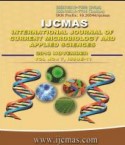


 National Academy of Agricultural Sciences (NAAS)
National Academy of Agricultural Sciences (NAAS)

|
PRINT ISSN : 2319-7692
Online ISSN : 2319-7706 Issues : 12 per year Publisher : Excellent Publishers Email : editorijcmas@gmail.com / submit@ijcmas.com Editor-in-chief: Dr.M.Prakash Index Copernicus ICV 2018: 95.39 NAAS RATING 2020: 5.38 |
India accounts for 30% of neonatal deaths globally. Bacterial sepsis is a significant cause of morbidity and mortality in newborns. The study helps to make antibiotic policy in neonatal sepsis. The main objective is to study the incidence of multidrug resistant gram negative and gram positive organisms causing neonatal septicemia and their antibiotic sensitivity pattern. The study was conducted in the Department of Microbiology over a period of one year. Sample of blood was collected under aseptic precautions and processed by standard techniques. Microorganisms were identified by Gram staining, standard biochemical tests and appropriate antibiograms. The common microorganisms responsible for neonatal sepsis were identified, and the resistant strains were studied. After identification and antibiotic susceptibility testing, beta-lactamases were detected as per CLSI guidelines. In 233 blood cultures 18.9 % (44/233) culture positivity was seen. Out of them, 31 (70.5%) were Gram negative and 13(29.5%) were Gram positive. Klebsiella pneumoniae subspecies pneumoniae (45.5%) was the most common isolate. ESBL producers were maximum (54.8%.) 25.8% of the isolates were positive for AmpC production. The diverse microbiological pattern of neonatal septicaemia demands the need for review of neonatal sepsis. The evaluation of the pathogens and their antibiotic susceptibility is a relevant guide in the antibiotic therapy.
 |
 |
 |
 |
 |